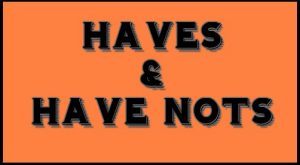The Haves and Have-Nots Explained

Have you ever heard the ‘haves and have-nots’ expression and wondered what it really meant? Some idioms – a group of words or manner of speaking that have a different meaning from what the text says or implies – are often confusing; especially to those who are not familiar with them. One of those idioms are the have and have-nots. This is one grammar question many people often ask. The haves and have-nots is explained below. Understanding its meaning, origin and usage can help you use it correctly.
The Origin Of The Haves And Have-Nots
The haves and have-nots may appear as if it’s grammarly incorrect when you first look at it. However, it is not. The phrase is quite common, very popular and widely used in American society. Before we delve into the origin of this idiom, we must first go over its meaning. The haves and have-nots refers to two kinds of people; the wealthy and the poor. In society, the income gap that separates these two groups of people, can be defined using this expression.
You should also take a look at Idioms and Metaphors
Although it is not exactly known when the first usage of the haves and have-nots began, the latter dates back all the way to 1700’s and earlier. What is known however, is that it was used in a derogatory way to some extent. When someone would refer to a person as a have-not, they meant anyone who was living in poverty or did not have much money. Those that fell into the ‘have-nots’ category, were looked upon as less than those that had it. Once those that ‘had it’ – meaning money and wealth – were coined as the ‘haves’, the two words became a very popular phrase and idiom.
Understanding Idioms
While one may think that the actual word ‘haves’ would be grammatically incorrect, the truth is that it is not. Whenever anyone is searching for the definition of it, the answer is simply given as ‘people with plenty of money and possessions.’
To those who are native English speakers, the have and have-nots idiom is a perfectly natural way of speaking. The same can be said for many other idioms or phrases. The difference is that those who are not native English speakers, may often have trouble understanding their meanings. Still, once you begin to research each idiom, then the usage becomes clear. As time goes by, new idioms will be created and added to our dictionary and languages. Every idiom or phrase originates in a native language and sometimes, it may catch on in another. Nevertheless, in most cases, it will only make sense in the language it originated from.
Here are Six Important Grammar Rules You Need To Know
A New Hit Show
A few years ago, a TV series named “The Haves and Have Nots” was released. The show has now been on for a few seasons and has a large following. It is hard to believe that what once began as an idiom has now become a TV show as well. This is one time when TV is imitating the English grammar.
In the end, the haves and have-nots started as a way to prejudicially distinguish a group of people from the other. Yet the truth is that in life, there are those that have and those that have nots.
